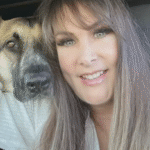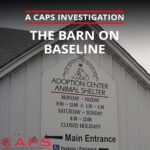Breeder: Parker, Melvin and Bonnie
Business name: Parker’s Pet Puppys
Address: 984 E U Hwy
City, State Zip: Golden City, MO 64718
Year: 2004
USDA License: 43-A-1469
USDA Inspector: David Brigance, ACI
USDA Inspections: 2003-03-03
Date of CAPS Investigation: 2004-10-08
Approximately 27 dogs and 1 puppy. Breeds: Labradors, Golden Retrievers, German Short-haired Pointers
Two sets of 12 pens each
Melvin and Bonnie Parker’s kennel was about eight hundred feet from the side of his house facing away from the road accessing the property. The kennel primarily consisted of two sets of 12 pens, positioned about ten feet from each other. The pens were about four feet wide, eight feet long, and made of rusting chain link wiring about six feet high. Within each set, the pens were adjacent to each other and completely covered with a metal roof. Each pen housed a single adult Labrador or Golden Retriever. The pens had metal water buckets, food dishes, and plastic barrel shelters.
The water buckets contained dirty water that was green from algae buildup (3.10-Watering), and the water buckets exhibited rust (3.1(c)(1)(i)-Surfaces). The top of one water bucket was torn and bent and had jagged edges sticking out (3.1(c)(1)(ii)-Maintenance and replacement of surfaces). Most of the food dishes were empty; dishes with some food in them contained standing water that completely soaked the food (3.9(a)-Feeding). All of the food dishes were placed on the pen floors and thus were not placed in a manner so as to minimize contamination by pests and excreta (3.9(b)-Feeding).
The barrels used for dog houses were each about 1.5 feet wide and four feet long. They had one-foot-square openings cut into one side to allow access. Untreated wooden boards were placed on the inside bottoms of the barrels to act as flat floorings (3.4(c)-Construction). Some of the barrels were wired to the backs of the pens so that the barrels protruded from the pens while other barrels were simply set on the pen floorings unsecured (3.1(a)-Structure; construction). The barrels were not of sufficient size to allow the dogs to be in them and turn about freely without rubbing up against the sides of the barrels (3.4(b)-Shelter from the elements). None of the entrances to the barrels had wind/rain breaks on them (3.4(b)(3)-Shelter from the elements).
In two of the pens, chain link wiring with hair build-up was protruding into the pens (3.1(b)-Condition and site) (3.1(c)(1)(ii)-Surfaces). In one of these pens, a piece of rusty, thick-gauge galvanized wire about four feet high and six feet wide had been wired to the wall over a one-foot-high and three-foot-wide hole in the chain link as an alternative to repairing or replacing the wall with jagged wire (3.1(a)-Structure; construction) (3.1(c)(1)(i)-Surfaces). Another chain link hole was about a foot high and two feet long and dogs could pass through it (3.1(a)-Structure; construction).
A water spigot and hose were within ten feet of these pens toward the direction of the Parkers’ house.
Set of four pens
A set of four pens was about 80 feet from the pens described above and were positioned adjacent to each other in a row. Each pen was about four feet wide and eight feet long. They had six-foot-high chain link walls around them. The pens had no roofing and the dirt flooring was mostly covered with small grey rocks. Two pens each housed a single adult German Short-Haired Pointer, a third appeared empty, and a fourth contained a three-month-old Labrador-mix puppy.
Each pen had a metal water bucket with algae growing in it on the pen flooring (3.10-Watering) and food dishes that were either empty or filled with soaked food and standing water (3.9(a)-Feeding). The food dishes were placed on the pen floorings and were not placed so as to minimize contamination by pests and excreta (3.9(b)-Feeding). Each pen had more than 24 hours’ accumulation of feces on the flooring, including the pen that appeared empty (3.11(a)-Cleaning of primary enclosures).
Each pen had blue plastic barrels that were about 1.5 feet wide and four feet long. Three barrels were attached to the outside of a pen wall so that the barrels were not in the pens themselves. One barrel had a door made of untreated wood with rusting metal hinges (3.1(c)(1)(i)-Surfaces) (3.4(c)-Construction). The door did not close behind a dog entering the barrel and did not serve as wind/rain breaks (3.4(b)(3)-Shelter from the elements).
A fourth barrel, which was in a pen housing a German Short-haired Pointer pen, was on the pen floor against a dying trunk protruding from the pen flooring against the front wall of the pen itself (3.1(a)-Structure; construction) (3.1(b)-Condition and site). Half of the door to this pen was torn off (3.1(c)(2)-Maintenance and replacement of surfaces) (3.4(b)(3)-Shelter from the elements).
The other pen housing a German Short-haired Pointer had a tree truck resting on the flooring against the front wall. This trunk was not growing out of the ground but appeared to have been placed there (3.1(a)-Structure; construction) (3.1(b)-Condition and site).
Chained dog
An adult male Labrador Retriever was within 40 feet of the pens on concrete flooring. The dog had a 15-foot chain from its collar to a metal stake in the ground. (3.6(c)(4)-Primary enclosures). This Lab had access to a blue plastic barrel about 1.5 feet wide and four feet long. The barrel was against a tree within 10 feet of the stake. The barrel was not large enough for the dog to turn around in without rubbing up against the sides of the barrel (3.4(b)-Shelter from the elements). The entrance to the barrel, a one-foot-wide and one-foot-high door, did not have a wind/rain break (3.4(b)(3)-Shelter from the elements). It had rusty broken hinges (3.1(c)(1)(i)-Surfaces) and an untreated, worn wooden floor (3.4(c)-Construction)
The dog’s food dish was broken and empty, and the dish was placed on the ground in a manner that did not minimize contamination by excreta or pests (3.9(b)-Feeding). The ground around the dog had more than 24 hours’ accumulation of feces on it (3.11(a)-Cleaning of primary enclosures). No fencing surrounded the dog or his food, water and dog house (3.1(a)-Structure; construction).
A rusting metal trough, at least a dozen tires, a pile of brush and tree limbs, old dog cages, unused dog houses, several large piles of timber, and metal beams were within 20 to 40 feet of the dog pens (3.11(c)-Housekeeping for premises).
Download attachments:Parker-1.pdf
Parker-2.pdf
Parker-3.pdf
Parker-4.pdf
Parker-5.pdf
Parker-6.pdf




